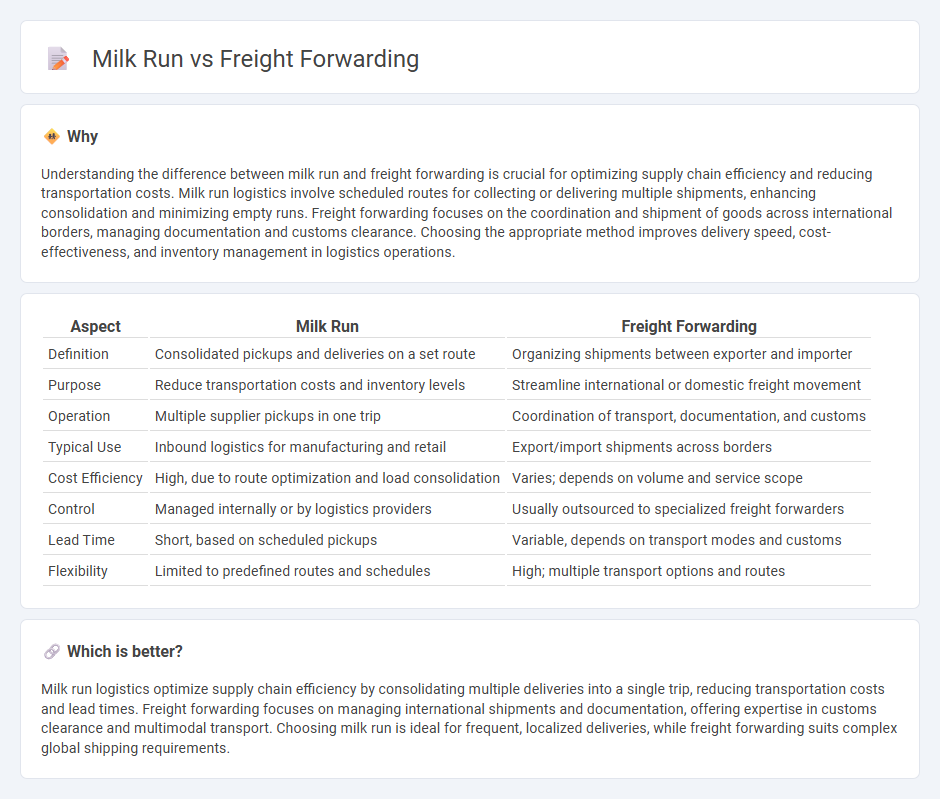
Milk run logistics optimizes supply chains by scheduling frequent, smaller shipments from multiple suppliers to a single destination, reducing inventory costs and improving delivery reliability. Freight forwarding focuses on managing the shipment of goods internationally or domestically through various transportation modes, ensuring efficient customs clearance and freight consolidation. Explore the key differences and benefits of milk run versus freight forwarding to enhance your logistics strategy.
Why it is important
Understanding the difference between milk run and freight forwarding is crucial for optimizing supply chain efficiency and reducing transportation costs. Milk run logistics involve scheduled routes for collecting or delivering multiple shipments, enhancing consolidation and minimizing empty runs. Freight forwarding focuses on the coordination and shipment of goods across international borders, managing documentation and customs clearance. Choosing the appropriate method improves delivery speed, cost-effectiveness, and inventory management in logistics operations.
Comparison Table
| Aspect | Milk Run | Freight Forwarding |
|---|---|---|
| Definition | Consolidated pickups and deliveries on a set route | Organizing shipments between exporter and importer |
| Purpose | Reduce transportation costs and inventory levels | Streamline international or domestic freight movement |
| Operation | Multiple supplier pickups in one trip | Coordination of transport, documentation, and customs |
| Typical Use | Inbound logistics for manufacturing and retail | Export/import shipments across borders |
| Cost Efficiency | High, due to route optimization and load consolidation | Varies; depends on volume and service scope |
| Control | Managed internally or by logistics providers | Usually outsourced to specialized freight forwarders |
| Lead Time | Short, based on scheduled pickups | Variable, depends on transport modes and customs |
| Flexibility | Limited to predefined routes and schedules | High; multiple transport options and routes |
Which is better?
Milk run logistics optimize supply chain efficiency by consolidating multiple deliveries into a single trip, reducing transportation costs and lead times. Freight forwarding focuses on managing international shipments and documentation, offering expertise in customs clearance and multimodal transport. Choosing milk run is ideal for frequent, localized deliveries, while freight forwarding suits complex global shipping requirements.
Connection
Milk run routes optimize freight forwarding by consolidating shipments from multiple suppliers into a single delivery schedule, reducing transportation costs and enhancing efficiency. Freight forwarding companies coordinate these milk run collectives to streamline supply chain logistics, ensuring timely and cost-effective distribution. This integration minimizes transit times and improves inventory management across supply networks.
Key Terms
Freight Forwarding:
Freight forwarding involves organizing shipments for individuals or corporations to get goods from the manufacturer or producer to a market, customer, or final point of distribution. It leverages comprehensive logistics services including customs clearance, warehousing, and cargo insurance to optimize global supply chain efficiency. Discover more about how freight forwarding can streamline your international shipping needs.
Customs Clearance
Freight forwarding streamlines Customs Clearance by managing documentation, compliance, and coordination with authorities to ensure timely shipment release. Milk run logistics optimizes Customs processes through consolidated shipments, reducing clearance times and minimizing customs fees. Explore how each method enhances Customs Clearance efficiency for your supply chain needs.
Multi-modal Transport
Freight forwarding involves coordinating shipments across multiple carriers to optimize routes and costs, focusing on efficiency and global reach through multi-modal transport, which integrates sea, air, rail, and road logistics. Milk run logistics, on the other hand, streamlines multi-modal transport by consolidating shipments from multiple suppliers into a single transport cycle, reducing shipping costs and environmental impact. Explore more about how these strategies enhance supply chain management through advanced multi-modal transport solutions.
Source and External Links
What is freight forwarding? | Clarksons - Freight forwarding is the strategic planning and coordination of the international movement of goods via multiple transport modes, acting as an intermediary that handles logistics, customs clearance, and shipping to ensure timely delivery.
What Is Freight Forwarding? Definition, Benefits and Key Stages - Freight forwarding involves several key stages including export haulage, export customs clearance, and origin handling where shipments are inspected and prepared for international transit by experts who manage compliance and logistics details.
About Freight Forwarding - FIATA - Freight forwarding encompasses services related to carriage, consolidation, storage, handling, and distribution of goods, with forwarders ensuring goods move internationally from origin to destination efficiently, including customs and insurance management.
 dowidth.com
dowidth.com